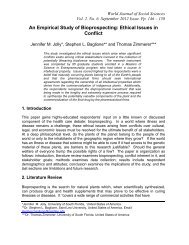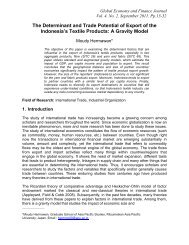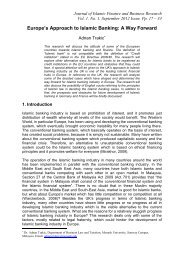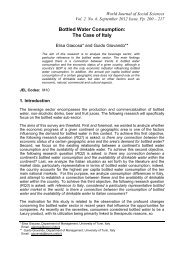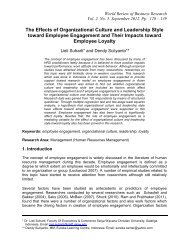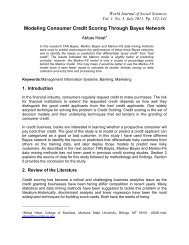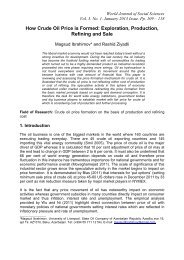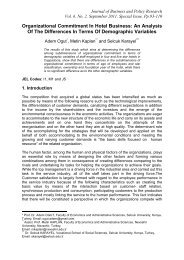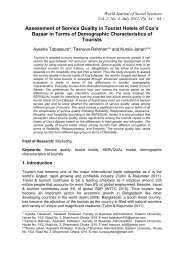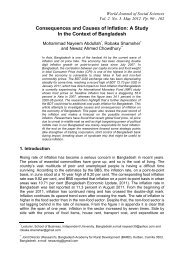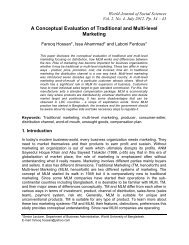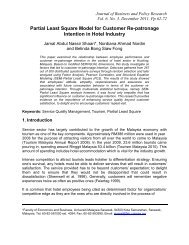Muhammad Faisol Chowdhury - Wbiaus.org
Muhammad Faisol Chowdhury - Wbiaus.org
Muhammad Faisol Chowdhury - Wbiaus.org
Create successful ePaper yourself
Turn your PDF publications into a flip-book with our unique Google optimized e-Paper software.
World Review of Business ResearchVol. 1. No. 2. May 2011 Pp. 153 - 167Performance Management Practices in OrganizationsOperating in Bangladesh: A Deeper Examination<strong>Muhammad</strong> <strong>Faisol</strong> <strong>Chowdhury</strong>*This paper examines the performance management practices (PMS)in local private <strong>org</strong>anizations and multinational companies (MNC)operating in Bangladesh by identifying the current prevalence of PMSand exploring the extent of performance evaluation outputs linked withother HR decisions. The study builds on empirical and theoreticalexaminations by collecting data via questionnaire from 200 localcompanies and 52 MNCs. Investigating the prevalence and pattern ofHRM practices, this paper finds that local <strong>org</strong>anizations need more ofa make-over in relation to the adoption of a more appropriate andstrategic PMS in comparison to the MNCs operating in the country.Field of Research: Human Resource Management, Performance ManagementSystem.1. IntroductionHuman resource is a nation‟s prime asset, a company‟s prime asset, an<strong>org</strong>anization‟s prime asset. Nowhere is this more true than in Bangladesh, due to itslarge population size and high population density. A development strategy in thiscountry that does not put human resource at the top of its priorities would underminethe development process itself. Bangladesh‟s biggest development success storiesall capitalized on the country‟s number one resource: its people. Like everythingelse, the span of human resource management is changing fast.In the present socioeconomic scenario, assets such as machinery, technology andaccess to capital are losing their competitive advantage. While machinery can besourced from any part of the world, capital can be raised from the market and therelentless pace of technological advancement makes many innovations obsolete in amatter of days. To counter these issues, companies globally are searching for waysto build unique assets for establishing a sustainable competitive advantage in theirtarget markets. This calls for a need to continuously innovate and the only asset thatcan be a source of sustainable value is human capital. The employees of an<strong>org</strong>anization with their complementary skills and knowledge hold the key tocompetitive strength in today‟s economy (HR Practices Survey BD 2006).The best way to harness this source of competitive strength is by developing and reorientingexisting HR practices to achieve <strong>org</strong>anizational goal and strategies.Successful companies across the world have geared up and achieved this byestablishing the right linkages between people practices and <strong>org</strong>anizational------------------------------------*<strong>Muhammad</strong> <strong>Faisol</strong> <strong>Chowdhury</strong>, Lecturer of HRM, School of Business, North South University,Dhaka, Bangladesh. Email: faisol.chowdhury@me.com
<strong>Chowdhury</strong>productivity. It is vital that <strong>org</strong>anizations and people who work for each other shouldsucceed together. As a result, <strong>org</strong>anizations need ever-improving performance tosurvive and prosper in today‟s competitive world: individual and <strong>org</strong>anizationperformance improvements are the keys to competitive advantage. Rapid change,tighter budgets, downsizing and restructuring, and pressures for greater employeeaccountability are placing greater emphasis on performance management bytranslating the <strong>org</strong>anization‟s objectives and strategies into individual job objectivesand performance standards (Stone 2002).Today, Bangladesh is pursuing a liberal market economy. This liberalization hasencouraged increased participation of the private sector and export orientedindustries and the growth of the service sector. Gradually, the assembling andmanufacturing sector is also growing, backed by ready availability of manpower.Moreover, large investments into the economy are coming in the form of jointventures and foreign direct investments (FDI) by the establishment of multinationalcompanies (MNC).At this moment, to sustain and compound the economic growth of Bangladesh, it isthe need of the hour to conduct a study on the traditional local and newly enteredhigh-performing MNCs. With the view of identifying and understanding howperformance management system (PMS) is being practiced for <strong>org</strong>anizationalgrowth, this paper aims to scrutinize the adoption and practice of PMS by 252 localcompanies and MNCs operating in Bangladesh. Furthermore, this paper attempts toexplore the span of performance evaluation outputs linked with other HR decision inthese <strong>org</strong>anizations. In addition to the empirical evidence, the article discusses aboutthe successful attempt by the MNCs to align their business strategies with robustPMS. The article at first features the literature review. Next, research objectives andquestions are outlined. Following the discussion of research design and presentationof survey analysis, the results are discussed in terms of the implications for the<strong>org</strong>anizational growth prospects significantly depend on how well its human resourcecapabilities and PMS approaches are developed and utilized across <strong>org</strong>anizations.2. Literature ReviewPMS is a tool used by <strong>org</strong>anizations to guide performance behavior in alignment tothe <strong>org</strong>anization strategy. It is a holistic process, bringing together many of theelements which go to make up the successful practice of people management,including in particular learning and development (CIPD 2010). Empirical researchsuggests a positive correlation between the effective use of PMS as a tool andbusiness result. Armstrong and Baron (2004) defined PMS as a process whichcontributes to the effective management of individuals and teams in order to achievehigh levels of <strong>org</strong>anizational performance. Wiesner and McDonald (2001) in theirresearch regarding the prevalence of PMS practices in Australian companiesrevealed a high adoption of the system and a link of performance evaluation outputwith five different HRM activities. In relation to the extent to which this prevalencehas represented change over ten years, in 2010, Wiesner and Innes (2010)measured the PMS practices again in Australian companies and revealedincrements in use of PMS and significant use of performance evaluation output withmore than five HRM activities. These researchers went on to stress that PMS is a154
<strong>Chowdhury</strong>strategy which relates to every activity of the <strong>org</strong>anization set in the context of itshuman resource policies, culture, style and communications systems. The nature ofthe strategy depends on the <strong>org</strong>anizational context and can vary from <strong>org</strong>anization to<strong>org</strong>anization (Armstrong & Baron 2004).Performance evaluation output must be linked with other HRM activities andstrategic decisions making for the <strong>org</strong>anizational administrative and developmentalpurposes (Greer 2001; Cleveland, Murphy & Williams 1989). Islam (2006) in hisstudy found that, fewer than 20 percent Bangladeshi <strong>org</strong>anizations hold PMS onregular basis and only 10 percent <strong>org</strong>anizations link performance evaluation resultwith HR decision making. Furthermore, performance evaluations were typicallybased on supervisor‟s subjective judgements rather than on objective indicators ofperformance (HR Practices Survey BD 2006). This has led many Bangladeshiresearchers to speculate that PMS practices in Bangladeshi local private<strong>org</strong>anizations are full of errors, for example, annual performance evaluation canplace an excessive burden on the memory of a person who has to rate multipleemployees, and thus can result in biased or wrong judgements (HR Bangladesh2011). Also, supervisors‟ judgements may be influenced by stereotypes and otherpersonal beliefs or perceptions (Zafour 2009; Haque & Hossain 2009). For thesereasons, dissatisfaction with PMS among the local private <strong>org</strong>anizations is rampant.On the other hand, recent empirical researches conducted by Mahmood (2010) andAbdullah, Boyle and Joham (2010) showed that MNCs operating in Bangladesh aremoving away from using a traditional approach of rating-scale based PMS and arefocusing on more sophisticated and strategic PMS. It is also evident from their studythat these MNC are using performance evaluation outputs administratively wheneverthey are the basis for a decision about the employee‟s work conditions, includingpromotions, terminations, remunerations and rewards. Developmental uses ofperformance evaluation, which are geared toward improving employees„performance and strengthening their job skills, include counseling employees oneffective work and behaviors.A US study showed that top global <strong>org</strong>anizations use performance measures „...thatfocus on all the drivers of their business - financial performance, shareholder value,employees and customers‟ (Stark & Alper, pp.62). Another public sector focusedthrough research conducted by Bouckaert and Halligan (2008) highlighted that themore the quality of PMS is, the better is the growth and development of<strong>org</strong>anizations. Research by Nankervis and Leece (1999, p.91) indicated that<strong>org</strong>anizations are trying to relate individual performance more directly to theirstrategic business objectives. Researchers like Fletcher (1997), Schleicher,Greguras and Watt (2004, p.170) argued that, despite the practical andpsychological problem with employing PMS, <strong>org</strong>anizations can significantly benefitfrom it, assuming of course that the appraisals are conducted objectively andeffectively. Strengthening this point of view is done by the researchers like Taorminaand Gao (2009, p.105), indicating that employee acceptance of performanceappraisal can be critical to the success of the whole PMS system. Therefore, oneimportant concern becomes how to make PMS less objectionable to the people whoare being evaluated (Bernardin & Beatty 1984).155
<strong>Chowdhury</strong>Furthermore, according to McDonald and Smith (1995), companies that managePMS successfully outperforms companies that do not, with higher profits, better cashflows stronger stock market preference, productivity gains, higher sales growth peremployee and overall better financial performance. Similar results are found in theresearch of Schneider, Shaw and Beatty (1991, p.290), Boxall and Purcell (2003)and Harley (2005, p.40).In contrast, Baxter and MacLeod (2008) in their research on European <strong>org</strong>anizationsidentified that PMS can have an adverse impact on <strong>org</strong>anization‟s performance ifconsiderable effort is not given on choosing the right PMS during change initiativesaimed at performance improvement. Lee and Son (1998, p.283) in their articlementioned that, PMS turns useless and counterproductive if not practiced by HRexperts in accordance with employees‟ reactions and <strong>org</strong>anization‟s goal, and<strong>org</strong>anizations turned into a „bleak house„ (Wiesner & Innes, 2010, p.173).Empirical evidences shows that strategic PMS penultimately makes a significantcontribution to <strong>org</strong>anization performance (Ghorpade & Chen 1995; Golhar &Deshpande 1997; Lublin 1994; Storey & Sisson 1993). Thus, <strong>org</strong>anizations that havestrategically implemented PMS and successfully linked its outcome with other HRMdecisions are deriving significant benefits including productivity improvements,<strong>org</strong>anizational improvements and enhanced strategic capabilities. (Dessler 2008;Dessler, Griffith & Lloyed-Walker 2004; Hedge & Teachout 2000; Haunstein 1998;Landy 1980).3. Research Objective and QuestionsIn the view of the discussion above, the objective of this research is to examine thePMS in local <strong>org</strong>anizations and MNCs operating in Bangladesh by identifying thecurrent prevalence of PMS and exploring the extent of performance evaluationoutputs linked with other HR decisions. Two research questions have beendeveloped over the principle HRM functional areas of performance management andperformance appraisal targeting the research objective above. The first questionfocuses on existing performance management system among the <strong>org</strong>anizationsoperating in Bangladesh and second question provides an insight into the extent ofHR activities which are linked with the performance evaluation results. Both thequestions focus on more than two hundred and fifty local and multinational<strong>org</strong>anizations operating in Bangladesh. These <strong>org</strong>anizations have been categorizedinto eight sectors: financial, pharmaceuticals and healthcare, manufacturing,conglomerates, information technology (IT) and telecom, ready-made garmentindustry (RMG), fast-moving consumer goods manufacturers (FMCG), and nongovernment<strong>org</strong>anizations (NGO).The research questions are:Question 1: What is the current prevalence of performance management system(PMS) in private local and multinational <strong>org</strong>anizations operating in Bangladesh?Question 2: To what extent the performance evaluation outputs are linked with otherHR decisions in these <strong>org</strong>anizations?156
<strong>Chowdhury</strong>4. Research Design4.1 The SurveyThe survey questionnaire was originally developed and validated by Human Capital,Ernst & Young Pvt. Ltd. India for the study of HR practices survey in Bangladesh in2006. This questionnaire was adapted for the 2010 study by adding relevantemergent HR practices which were not included in the original questionnaire. Theseemergent practices were identified by conducting an in-depth research and literaturereview on performance management system. The survey was systematicallydesigned to capture a representative view of performance management practices.Standard questionnaire-response approach was used. The questions weredistributed across a wide variety of items to collectively provide an exhaustivecoverage. A stratified sampling methodology was used to prepare a list of<strong>org</strong>anizations to be invited to participate in the survey. The criteria used forstratification were based on parameters which could substantially influenceperformance management practices of a country. The following three criteria werefinalized to stratify samples: (a) type of industry / sector, (b) ownership of the<strong>org</strong>anization, (c) stage of <strong>org</strong>anizational lifecycle.In this study, small businesses are constituted by 100 or fewer employees andmedium sized businesses range from 101 to 500 employees and large <strong>org</strong>anizationsby over 500 employees. As the lowest extremity for size, firms employing 10employees had been used because the research project is about performancemanagement system and such <strong>org</strong>anizations are expected to have a managementstructure.Out of 252 surveyed <strong>org</strong>anizations, 200 were local private <strong>org</strong>anizations and 52 wereMNCs. MNCs are considered as pioneer in practicing corporate governance in adeveloping country like Bangladesh where a little emphasis is given on practicingHRM by the local enterprises (Islam, 2006). It has been already accepted both indomestic and international market that employees are an important source ofcompetitive advantage for corporations (Peteraf 1993). It has also been found that ifPMS is linked to the overall business of a company, it may further enhance theperformance of the company (Pfeffer 1998). Moreover, due to the complexity ofmanaging people from different socio-economic and cultural background, it is arguedthat the way global employees are managed will also have a significant impact on afirm‟s economic outcome (Bjorkman & Xiucheng 2002). Thus, it has been noted thatfew MNCs know how to manage HR effectively in a dynamic internationalenvironment because best practices in one context do not always translate to othercontexts with differing socio-economic conditions and culture (Bouckaert & Halligan2008). However, in Bangladesh several MNCs are successfully in operation for thelast two decades (HR Practices Survey BD 2006). Despite the usual challenges ofimplementing ethnocentric HRM practices faced by MNCs operating in many foreigneconomy with different socio-economic and cultural orientations, most of the MNCsoperating in Bangladesh have been showing a fantastic performance by blending asignificant amount of local flavors with their home country HRM practices (Abdullah,Boyle & Joham 2010). As such, with the increasing presence of these MNCs withexcellent corporate governance and HRM practices in the economy, it is unjustified157
<strong>Chowdhury</strong>not to take these MNCs into the research sample for a better understanding thesubject matter.4.2 Secondary SourcesFor an in-depth analysis of the topic and research questions, information were alsogathered from empirical studies and researches, peer reviewed business journalarticles, business magazines, reference books and internet website.4.3 Survey Analysis ToolThe survey data reviewed were collected and analyzed on the basis of the surveyframework to generate a meaningful and informative summary. The analysis wasobjective in nature and did not include opinions or judgements which were notbacked by supporting data (either qualitative or quantitative). Trends across all areasof HR were compiled and represented in the form of graphs and chart with possibleexplanations based on the business and cultural context of Bangladesh. Articles andpapers were also compiled with the survey analysis to get highlights of evolving HRpractices.iWork Numbers 2009 spreadsheet software was used to generate table and chartsfor data representation.5. ResultsThis section reports the results regarding the study‟s two research questions.In order to get the answer of the first research question where this study was tryingto identify the current prevalence of PMS in private <strong>org</strong>anization of Bangladesh, chart1 shows the results regarding importance of implementing PMS in Bangladeshi<strong>org</strong>anizations.Chart 1: Importance of implementing PMS1007550250Financial Pharma Manufacturing Conglomerate IT/Telecom RMG FMCG NGO158
<strong>Chowdhury</strong>This survey probed into various tools and techniques used by <strong>org</strong>anizations tocapture and evaluate performance. As observed from the responses, chart 1 showsthat most of the sectors apart from NGOs and financial sectors considered itimportant to have a standard system to evaluate performance. In IT / telecom sector,100 percent of the surveyed <strong>org</strong>anizations responded positively that it is veryimportant to obtain, implement and manage a systematic PMS system. This isbecause, most of the surveyed telecommunication companies were MNCs and ITfirms were joint-ventures with investment from foreign entities. This finding highlightsthat, these <strong>org</strong>anizations have actually adopted a strategic PMS approach andimplemented it by understanding the importance of HRM decision making in light ofperformance evaluation outcomes. Moreover, conglomerates as well as textile andgarment industries, which were local and mostly family owned <strong>org</strong>anizations, hadalso understood the importance of having tools for PMS which showed a paradigmshift in traditional attitude. On the other hand, <strong>org</strong>anizations under NGO sector foundit less important to practice PMS. Anecdotal evidence by Islam (2006), and empiricalresearch by Haque and Hossain (2010) found that employee turnover rate is usuallyhigher in NGOs compared to other sectors because of the short-term contractualnature of employment. Moreover, most of the NGOs are involved in developmentactivities of rural people and areas, and thus, have less orientation with corporatemanagement style and practices. So, absence of HRM and PMS is evident in thissector.Almost all the participating <strong>org</strong>anizations had a performance appraisal form or formatto capture individual performance data. Most of the <strong>org</strong>anizations evaluated theiremployees on individual performance target and behavioral attributes. Whileanalyzing the survey results, it was also found that in many <strong>org</strong>anizations selfevaluationform was not a part of the performance evaluation system. In almost allcompanies the performance ratings were reviewed by the head of departments orimmediate superiors to the appraiser. In around 70 percent companies theperformance planning was done jointly by the employee and his / her supervisor toset the performance expectations at the beginning of the year, the performancerating was discussed with the employee by his / her superior or rater and the areasof improvement for the employee was identified and communicated to him / herduring the appraisal process. In all the <strong>org</strong>anizations the performance rating largelydepended on the employee‟s performance. Apart from that, in a substantialproportion of companies, the rating of an employee depended on the <strong>org</strong>anizationalperformance, the business unit or department‟s performance and team performance.However, in two-third of the companies belonging to the financial sector and morethan half of the conglomerates, the <strong>org</strong>anizational performance was not taken intoconsideration for the employee‟s rating.159
<strong>Chowdhury</strong>Chart 2: PMS system - all industry level (% yes)Confidential rating by supervisorSubjective evaluation by supervisorMBO (management by objective) based measurementKSA (knowledge, skill, ability) based measurementCompetency based measurementBSC (balance scorecard) based measurement0 20 40 60 80According to chart 2, nearly 80 percent <strong>org</strong>anizations followed a PMS that includescompetency based performance measurement of employees. Some other prominentelements of the PMS were confidential rating, subjective evaluation andManagement by Objectives (MBO). MBO is a process of defining objectives withinan <strong>org</strong>anization so that management and employees agree to the objectives andunderstand what they need to do in the <strong>org</strong>anization (Stone 2002). The prominentelements vary across industries. However, competency based assessment was themost prominent element of the PMS in most of the industries. As Losey, Meisingerand Ulrich (2005) suggested that <strong>org</strong>anizations worldwide are following the BalanceScore Card (BSC) approach to link the business objectives with individual resultsareas, this survey showed that only 30 percent of the surveyed <strong>org</strong>anizations inBangladesh were using BSC approach. BSC is a strategic performancemanagement and decision making tool which can be used both in implementingPMS and linking performance evaluation results with other HR strategic decisionmaking process. It is also used by managers to keep a track of the execution ofactivities by staff within their control and monitor the consequences arising fromthese actions (Dessler 2008). Furthermore, almost 50 percent surveyed<strong>org</strong>anizations responded that they follow a knowledge, skill and ability (KSA) basedPMS system to manager the overall performance of the employees and the<strong>org</strong>anizations.To get the answer of the second research question, this study tried to penetrate theexisting HRM practices of Bangladeshi <strong>org</strong>anizations to identify how their currentPMS systems were linked with other strategic HRM decision making process.160
<strong>Chowdhury</strong>Chart 3: Integration of performance evaluation with otherHRM decisionsTraining DecisionCareer progression decisionSalary decisionBonus & incentive decisionOrganiztional successOther decision0 20 40 60 80 100As can be seen from chart 3, most <strong>org</strong>anizations had responded positively as far asneed was concerned. The chart also proves that most participated <strong>org</strong>anizations,(almost 86 percent) were comfortable in linking employee performance withemployee career progression opportunities and promotions. In other words,employee promotion decisions largely depended on individual performance in these<strong>org</strong>anizations. In contrast, less <strong>org</strong>anizations (58 percent) had been identified inlinking employees‟ remuneration with their performance evaluation outcome.Moreover, the study also showed that in recent management practice, PMS hadtaken the place of employee „performance appraisal‟ or annual review. Thus, thefocus had been shifted from evaluation to the entire spectrum of employeeperformance analysis, performance development, training and developmentsessions, cross-training challenging assignments, 360 degree appraisal andfeedback. Additionally, this research also found out that performance ratings wereused for making decisions mostly regarding salary structure determination andcareer progression, which are significant consecutively at 93 percent and 89 percentconfidence level. However, the research suggested that among the participants fromthe conglomerates and RMG sector, less than 50 percent companies usedperformance rating for training need identification. This needs to go up gradually astraining and development of professionals would take a critical role in the growth ofthese businesses in the future.161
<strong>Chowdhury</strong>Table 1: Performance management linkage with principal HRM activities% of surveyed <strong>org</strong>anizations answering‘yes’FinancialPharma/HealthcManufacturingConglomeratesIT /TelecomRMGFMCGNGOFinal rating of employees is moderated by dept.heads for normalization50 57 44 33 75 20 40 71Competency data is used for employee rating 100 100 89 92 100 100100 100Performance management policies &procedures are available online for employeesPerformance management information of theemployees is tracked & stored in HRISPerformance rating is used for makingdecisions regarding training & developmentPerformance rating is used for makingdecisions regarding career progression100 57 39 33 75 20 100 2958 73 50 42 25 60 40 4392 71 61 50 75 40 100 86100 86 94 100 75 80 100 71Performance rating is used for making decisionregarding remuneration83 100 89 92 100 100100 100Performance rating is used for making decisionregarding rewards and incentives67 71 56 50 100 80 80 57Source: HR Practices Survey Bangladesh 2006, by Human Capital, Ernst & YoungAccording to chart 3 and table 1, two-third of the companies surveyed indicated thatthey use performance ratings for deciding employee bonus and incentives. In themanufacturing sector and in case of conglomerates, only about half of the<strong>org</strong>anizations surveyed had specific linkages of performance rating with variable pay.It showed that employees in these sectors were still comfortable with the fixed-payculture and the sector enjoyed a high level of retention of its people. Performanceevaluation outputs were also used to take decision regarding training and careerprogression. As mentioned in the Ernst & Young research on HR practices inBangladesh, “...the idea of talking about developmental needs is gradually seepinginto the cultural fabric of the country.” (HR Practices Survey BD 2006).Table 1 suggests that, in business sectors like manufacturing, local conglomerates,RMG, in less than 50 percent <strong>org</strong>anizations employee performance evaluationratings were moderated by the department heads for normalization. Most of the<strong>org</strong>anizations agreed to the point that they consider employees competency level toevaluate their performance. 100 percent banks and financial institutes had madetheir PMS policies and procedures available in the internet for their employees,whereas, this percentage is insignificant in all other sectors. For example, only 20percent surveyed <strong>org</strong>anizations under RMG sector had responded positively inmaintaining online version of their PMS policies and procedures. The prominentreason behind this is, 90 percent of the RMG sector employees are manufacturingworkers who are incapable of accessing computer and internet because of their noneducationalbackground. Moreover, link of PMS with decisions regarding employee162
<strong>Chowdhury</strong>remuneration, rewards and incentives were also dominant in these sectorscomprised with mostly MNCs.Significantly, it is observable from table 1 that, sectors which were largely constitutedof MNCs had high level of PMS adoption and implementation; suggesting a quitepositive climate for HR personnel to maintain a collateral connection between PMSwith other HR deliverables. On the other hand, significantly lower PMS involvementand connection with HRM decision making activities had been found in the sectorsdominated by the local private <strong>org</strong>anizations.6. Discussion on FindingsFrom the above findings, on an overall basis it is observable that, the private local<strong>org</strong>anizations which were surveyed placed medium importance in the adoption andimplementation of standardize PMS and its linkage with other HRM systems ordecisions. Most of these local companies had different types of PMS systems andprocesses in place. Evidently, some of them were not effective to bring any positivechange in the <strong>org</strong>anizational growth (HR Bangladesh 2011). However, in a countrywhere an „extended family‟ culture influences the management practices in most ofthe large conglomerates and other private companies (HR Practices Survey BD2006), it is pleasant to observe a paradigm shift in management attitude among thelocal private sector <strong>org</strong>anizations.The survey also pointed out certain problems related with PMS implementation andconnection with other HRM key activities and significant changes were required inthose areas. For instance, the integration of the PMS with HRIS (Human ResourceInformation System) was a distinct gap area. Integration with HRIS makescommunication timely and cost-effective. A small number of local privaterespondents had the PMS information stored and tracked in their HRIS. In case ofthe more traditional sectors like RMG, manufacturing and business conglomerates,the percentages were even lower. Transparency in performance appraisals was notcommon and PMS in most of the surveyed <strong>org</strong>anizations was only on pen andpaper. Competency based assessment was a recent entrant, adopted currently onlyby a few among all the surveyed local enterprises. Performance took the front seatwhereas assessment of potential was not getting the attention it deserves. Similarly,Performance evaluation outputs were not linked to other key elements of the HRvalue chain like training and development, career management and successionplanning. Furthermore, the PMS data had implication for many short term and longterm processes which were being ignored by most of the top authorities. The policiesand procedures also require proper documentation to bring confidence andtransparency in the system. While moving to more maturity in PMS, it would also bevery critical for the <strong>org</strong>anizations to use electronic database to manage historicaldata and to make the policies easily available. Also evident from the analysis of theresponses that there are scopes for adding more maturity in the sub-processes ofPMS, especially in the traditional sectors such as RMG, manufacturing, and in casesof business conglomerates.On the other hand, in almost all the surveyed MNCs, PMS was considered as one ofthe most important tools to successfully manage the performance of employees and163
<strong>Chowdhury</strong><strong>org</strong>anizations. For example, the survey indicated that most of the MNCs useddifferent kinds of effective performance evaluation tools to measure employeeperformance and performance ratings were being communicated properly to theemployees before and after the evaluation. Significantly, the research also suggeststhat the way performance was measured, managed, and linked with other HRMdecisions in different MNCs, varied as per the culture of the <strong>org</strong>anization and itsdiverse members and the nature of the industry. As mentioned earlier in thisresearch, what is good for one <strong>org</strong>anization may not be equally effective for another.According to the pioneer study of Hofstede (1980) on cultural dimensions, and themulti-phased, multi-method „GLOBE - Global Leadership and OrganisationalBehaviour Effectiveness‟ project examining the interrelationships between societalculture, <strong>org</strong>anizational culture, leadership and societal achievement on 62 societiesconducted by Javidan and Dastmalchian (2009, p.45) identified that culturalparameters of a country significantly impact relationships between <strong>org</strong>anizationalmembers, openness to evaluation and feedback, and other aspects which couldinfluence the choice of tools and processes for performance management. As thehistorical and cultural background of Bangladesh has hierarchical differences, whichaccording to the Hofstede‟s model known as „power distance‟, it had been customaryto consider the appraiser as more suitable to review performance. Thus, most of theparticipating MNCs of this research had maintained an efficient and effective processto use PMS and linking it with other HRM activities. In addition, the survey alsoidentified that, most MNCs had been able to successfully link a part of employeecompensation with employee‟s performance. The idea was to ensure that thesuperior performers get recognized and rewarded. Also it helped to link salarypayouts with <strong>org</strong>anization‟s performance.7. ConclusionBangladesh is standing at the threshold of socio-economic growth; with increasingcompetition between local <strong>org</strong>anizations with MNCs the performance pressure isincreasing. With the increasing presence of foreign funds and MNCs, the market hasbecome more competitive and the business environment more volatile. The countryis in a state of flux as far as the usage of standardized tools and processes related toPMS is concerned. Improving the process efficiency and building a performanceculture in the <strong>org</strong>anization require support and drive from the top management inwork and in principle.This article, as its starting point, clearly articulated the meaning and measure of PMSwhich could hold different meanings for different <strong>org</strong>anizations. Despite thisdifference, PMS alignment with business strategy must be the underlying philosophyof <strong>org</strong>anizational growth. The article revealed the existence of a complex and blurredinteraction between PMS and local private <strong>org</strong>anizations‟ corporate governance. Alow level of linkage of performance measurement outcome with other HR planningand activities had also been observed. This existing bureaucratic PMS practiced bymost surveyed <strong>org</strong>anizations has to be transformed into a more sophisticated, targetoriented PMS to ensure profitability through sustainable growth. Furthermore, thisstudy also showed that most of the surveyed MNCs had successfully been able toestablish a meaningful relationship between PMS and corporate strategy, thusgetting competitive advantage to sustain in the market for longer period of time.164
<strong>Chowdhury</strong>Performance ratings were used for salary determinations, increments andpromotions in almost all the surveyed MNCs.It is evident from the study that a high level of awareness in adopting a standardizedPMS had been observed among the surveyed MNCs, whereas, most of the local<strong>org</strong>anizations did find it critical in implementation. The survey also showed that rapidintegration with global market place had significantly changed management styles insome of the local <strong>org</strong>anizations of Bangladesh in recent decade, which is a positivething. MNCs, with their exposure to „best-in-class‟ systems and processes hadbrought in changes in the PMS practices. Similarly, some local businessconglomerates that had grown rapidly through the last few decades have beenfeeling the need for standardized systems and processes to measure and rewardperformance.„...PMS need to be geared up to unlock human potential….‟ (HR Practices SurveyBD 2006) considering this fact, this article suggested that the key to a great PMS isits ability to convert strategy into action in a measurable way. The local private<strong>org</strong>anizations at this stage require a leap in the right direction. Organizations mustfocus on designing robust PMS that facilitates setting of clear performanceexpectations on the job together with elimination of all roadblocks that preventemployees from achieving them. In facilitating the PMS approach with proper linkagewith other HR deliverables, it must be emphasized that adoption of a „best practice„pioneered by the MNCs is a necessary tool for increasing sustainability, meetingcustomer needs and maximizing competitive advantage.ReferencesAbdullah, AB, Boyle, S & Joham, C 2010, „Role of cultural factors in shapingHRM practices in the MNCs operating in the emerging markets of South Asia‟,Proceedings of the International Business Research Conference, Dhaka,viewed 10 April 2011,Armstrong, M & Baron, A 2004, Managing performance: performance managementin action, CIPD, London.Baxter, LF & MacLeod, AM 2008, Managing performance improvement, Routledge,New York.Bernardin, HJ & Beatty, RW 1984, Performance appraisal: Assessing humanbehavior at work, Kent Publication, New York.Bjorkman, I & Xiucheng, F 2002, „Human resource management and theperformance of western firms in China‟, International Journal of Human ResourceManagement, vol. 13, no. 6, pp. 183 - 203.Bouckaert, G & Halligan, J 2008, Managing performance: International comparisons,Routledge, New York.Boxall, P & Purcell, J 2003, Strategy and human resource management, PalgraveMacmillan, New York.CIPD Chartered Institute of Personnel and Development 2011, Performancemanagement: an overview, viewed 17 January 2011,165
<strong>Chowdhury</strong>Cleaveland, JN, Murphy, KR & Williams, RE 1989, „Multiple uses of performanceappraisals: Prevalence and correlates, Journal of Applied Psychology, vol. 74, pp.130 - 135.Dessler, G 2008, Human Resource Management, 11th edn, Prentice Hall, USA.Dessler, G, Griffiths, J & Lloyd-Walker, B 2004, Human Resource Management,2nd edn, Pearson Education, Australia.Fletcher, C 1997, Appraisal: Routes to improved performance, 2nd edn, CIPD, UK.Greer, CR 2001, Strategic Human Resource Management, 2nd edn, Prentice Hall,USA.Ghorpade, J & Chen, MM 1995, „Creating quality driven performance appraisalsystems‟, Academy of Management Executive, vol. 9, no. 1, pp. 32 - 45.Golhar, DY & Deshpande, SP 1997, „HRM practices of large and small Canadianmanufacturing firms‟, Journal of Small Business Management, vol. 35, no. 3, pp.30 - 39.Haque, A & Hossain, M 2010, „Performance evaluation of bangladeshi apparel andtextile supply chain network: A case study‟, Proceedings of the InternationalBusiness Research Conference, Dhaka, viewed 12 April 2011,Harley, B 2005, „Hope or hype? High-performance work systems‟, Participation andDemocracy at Work, Palgrave Macmillan, USA.Haunstein, NM 1998, Training raters to increase the accuracy of appraisals and theusefulness of feedback, Jossey-Bass, USA.Hedge, JW & Teachout, MS 2000, „Exploring the concept of acceptability as acriterion for evaluation performance‟, Group and Organization Management, vol.25, no. 1, pp. 22 - 44.Hofstede, GH 1980, Culture’s consequences: International differences in workrelated values, Sage Publication, USA.HR Bangladesh 2011, Performance appraisal, viewed 1 May 2011,HR Practices Survey Bangladesh 2007, Human Capital - Ernst & Young India Pvt.Ltd. and MCCI (Metropolitan Chamber of Commerce and Industry), Bangladesh.Islam, KA 2006, In the Wonderland of Bangladeshi Managers, Boi Bazaar,Bangladesh.Javidan, M & Dastmalchian, A 2009, „Managerial implications of the GLOBE project:A study of 62 countries‟, Asia Pacific Journal of Human Resources, vol. 47, no. 1,pp. 41 - 58.Landy, FJ & Farr, JL 1980, „Performance ratings‟, Psychological Bulletin, vol. 87, pp.72 - 107.Lee, M & Son, B 1998, „The effects of appraisal review content on employees;reactions and performance‟, International Journal of Human ResourceManagement, issue. 1 February, pp. 283 - 305.Losey, M, Meisinger, S & Ulrich, D 2005, The future of human resourcemanagement, John Wiley & Sons, USA.Lublin, JS 1994, „Firms are re-evaluating their performance reviews‟, Asian WallStreet Journal, issue: 7 - 8, October, pp. 5.McDonald, D & Smith, A 1995, „A proven connection: performance managementand business results‟, Compensation and Benefits Review, vol. 27, no. 1, pp. 59 -75.166
<strong>Chowdhury</strong>Mahmood, M 2010, „Strategy, structure and HRM practices in multinationalsubsidiaries: European MNCs in a developing country context‟, Proceedings ofthe International Business Research Conference, Dhaka, viewed 12 April 2011conference proceedingsNankervis, AA & Leece, P 1997, „Performance appraisal: two steps forward, onestep back?‟, Asia Pacific Journal of Human Resources, vol. 35, no. 2, pp. 90 -108.Pfeffer, J 1998. The Human Equation, Harvard Business School Press, USA.Peteraf, MA 1993, „The cornerstones of competitive advantage: A resource basedview‟, Strategic Management Journal, vol. 14. pp. 179 - 191.Schleicher, DJ, Greguras, GJ, & Watt, JD 2004, „Reexamining the jobsatisfaction - performance relationship: The complexity of attitudes‟, Journal ofApplied Psychology, vol. 89, no. 1, pp. 165 - 177.Schneider, CE, Shaw, DG & Beatty, RW 1991, „Performance measurement andmanagement a tool for strategy execution‟, Human Resource Management,vol. 30, no. 3, pp. 279 - 302.Stark, M & Alper, W 2000, „Measuring people power‟, Fortune, vol. 142, no. 7, pp. 62- 70Stone, RJ 2002, Human Resource Management, 4th edn, John Wiley & Sons,Australia.Storey, J & Sisson, K 1993, „Performance management and the psychologicalcontract‟, Human Resource Management Journal, vol. 7, no. 1 pp. 57 - 72.Taormina, RJ & Gao, JH 2009, „Identifying acceptable performance appraisalcriteria: An international perspective‟, Asia Pacific Journal of Human Resources,vol. 47, no. 1, pp.102 - 125.Wiesner, R & McDonald, J 2001, Bleak house or bright prospect? Human resourcemanagement in Australian SMEs. Asia Pacific Journal of Human Resources, vol.39, no. 2, pp. 31 - 53.Wiesner, R & Innes, P 2010, „Bleak house or bright prospect?: HRM in AustralianSMEs over 1998 - 2008‟, Asia Pacific Journal of Human Resources, vol. 48, no.2, pp. 151 - 184.Zafour, A 2009, Human resource management practices in Bangladeshi<strong>org</strong>anizations, viewed 5 March 2011, available at:167



